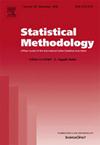广义渐进混合滤波方案下指数分布的精确似然推断
Q Mathematics
引用次数: 39
摘要
Chandrasekar等人(2004)提出的广义i型和ii型混合审查方案被扩展到渐进式ii型审查数据。使用Cramer和Balakrishnan(2013)提出的基于间隔的方法,我们获得了mle密度函数的显式表达式。所得公式以b样条函数形式给出,以便在计算机上方便有效地实现。本文章由计算机程序翻译,如有差异,请以英文原文为准。
Exact likelihood inference for exponential distributions under generalized progressive hybrid censoring schemes
Generalized Type-I and Type-II hybrid censoring schemes as proposed in Chandrasekar et al. (2004) are extended to progressively Type-II censored data. Using the spacings’ based approach due to Cramer and Balakrishnan (2013), we obtain explicit expressions for the density functions of the MLEs. The resulting formulas are given in terms of B-spline functions so that they can be easily and efficiently implemented on a computer.
求助全文
通过发布文献求助,成功后即可免费获取论文全文。
去求助
来源期刊

Statistical Methodology
STATISTICS & PROBABILITY-
CiteScore
0.59
自引率
0.00%
发文量
0
期刊介绍:
Statistical Methodology aims to publish articles of high quality reflecting the varied facets of contemporary statistical theory as well as of significant applications. In addition to helping to stimulate research, the journal intends to bring about interactions among statisticians and scientists in other disciplines broadly interested in statistical methodology. The journal focuses on traditional areas such as statistical inference, multivariate analysis, design of experiments, sampling theory, regression analysis, re-sampling methods, time series, nonparametric statistics, etc., and also gives special emphasis to established as well as emerging applied areas.
 求助内容:
求助内容: 应助结果提醒方式:
应助结果提醒方式:


